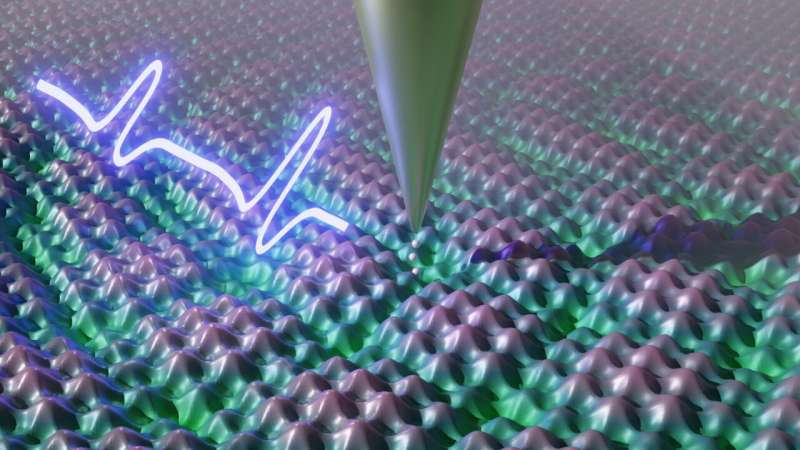This article has been reviewed according to Science X's editorial process and policies. Editors have highlighted the following attributes while ensuring the content's credibility:
fact-checked
peer-reviewed publication
trusted source
proofread
Quantum microscopy study makes electrons visible in slow motion

Physicists at the University of Stuttgart under the leadership of Prof. Sebastian Loth are developing quantum microscopy which enables them for the first time to record the movement of electrons at the atomic level with both extremely high spatial and temporal resolution.
Their method has the potential to enable scientists to develop materials in a much more targeted way than before. The researchers have published their findings in Nature Physics.
"With the method we developed, we can make things visible that no one has seen before," says Prof. Loth, Managing Director of the Institute for Functional Matter and Quantum Technologies (FMQ) at the University of Stuttgart. "This makes it possible to settle questions about the movement of electrons in solids that have been unanswered since the 1980s." The findings of Loth's group are also of very practical significance for the development of new materials.
Tiny changes with macroscopic consequences
In metals, insulators, and semiconductors, the physical world is simple. If you change a few atoms at the atomic level, the macroscopic properties remain unchanged. For example, metals modified in this way are still electrically conductive, whereas insulators are not.
However, the situation is different in more advanced materials, which can only be produced in the laboratory—minimal changes at the atomic level cause new macroscopic behavior. For example, some of these materials suddenly change from insulators to superconductors, i.e., they conduct electricity without heat loss.
These changes can happen extremely quickly, within picoseconds, as they influence the movement of electrons through the material directly at the atomic scale. A picosecond is extremely short, just a trillionth of a second. It is in the same proportion to the blink of an eye as the blink of an eye is to a period of more than 3,000 years.
Recording the movement of the electron collective
Loth's working group has now found a way to observe the behavior of these materials during such small changes at the atomic level. Specifically, the scientists studied a material consisting of the elements niobium and selenium in which one effect can be observed in a relatively undisturbed manner: the collective motion of electrons in a charge density wave.
Loth and his team investigated how a single impurity can stop this collective movement. For this purpose, the Stuttgart researchers apply an extremely short electrical pulse, which lasts just one picosecond, to the material. The charge density wave is pressed against the impurity and sends nanometer-sized distortions into the electron collective, which cause highly complex electron motion in the material for a short time.
Important preliminary work for the results now presented was done at the Max Planck Institute for Solid State Research (MPI FKF) in Stuttgart and at the Max Planck Institute for the Structure and Dynamics of Matter (MPSD) in Hamburg, where Loth had been conducting research before he was appointed to the University of Stuttgart.
Developing materials with desired properties
"If we can understand how the movement of the electron collective is stopped, then we can also develop materials with desired properties in a more targeted manner," Loth explains. Or to put it another way: As there are no perfect materials without impurities, the microscopy method developed helps to understand how impurities should be arranged in order to achieve the desired technical effect.
"Design at the atomic level has a direct impact on the macroscopic properties of the material," says Loth. The effect could be used, for example, for ultra-fast switching materials in future sensors or electronic components.
An experiment repeated 41 million times per second
"There are established methods for visualizing individual atoms or their movements," explains Loth. "But with these methods, you can either achieve a high spatial resolution or a high temporal resolution."
For the new Stuttgart microscope to achieve both, the physicist and his team combine a scanning tunneling microscope, which resolves materials at the atomic level, with an ultrafast spectroscopy method known as pump-probe spectroscopy.
In order to make the necessary measurements, the laboratory setup must be extremely well shielded. Vibrations, noise, and air movement are harmful, as are fluctuations in room temperature and humidity. "This is because we measure extremely weak signals that are otherwise easily lost in the background noise," Loth points out.
In addition, the team has to repeat these measurements very often in order to obtain meaningful results. The researchers were able to optimize their microscope in such a way that it repeats the experiment 41 million times per second and thus achieves a particularly high signal quality. "Only we have managed to do this so far," says Loth.
More information: Shaoxiang Sheng et al, Terahertz spectroscopy of collective charge density wave dynamics at the atomic scale, Nature Physics (2024). DOI: 10.1038/s41567-024-02552-7
Journal information: Nature Physics
Provided by University of Stuttgart





















